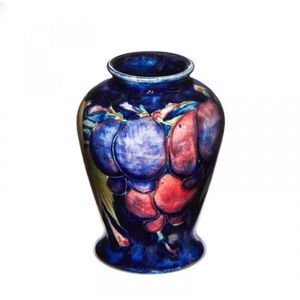Moorcroft Flambe Wisteria Vase (23cm)
You must be a subscriber, and be logged in to view price and dealer details.
Subscribe Now to view actual auction price for this item
When you subscribe, you have the option of setting the currency in which to display prices to $Au, $US, $NZ or Stg.
- Circa - A Latin term meaning 'about', often used in the antique trade to give an approximate date for the piece, usually considered to be five years on either side of the circa year. Thus, circa 1900 means the piece was made about 1900, probably between 1895 and 1905. The expression is sometimes abbreviated to c.1900.
- Dating English Ceramics - Excellent detailed reference books such as Godden's Encyclopaedia of British Pottery and Porcelain Marks will help to identify and date specific manufacturer's marks.
However, there are a few simple guidelines which may also help.
The inclusion of the word 'England' on an item ensured compliance with the American McKinley Tariff Act 1891, which was important for British exporters. An item so marked would have been made after 1891.
In 1921 the act was revised to require the phrase 'Made in' followed by the country. So if an item is marked 'Made in England', it is generally considered to be made after that date, although some manufacturers were using this phrase pior to the act being changed.
The use of the word 'Ltd' of 'Limited' after a company's name indicates a date after 1860, though with ceramic manufacturers this did not become general practice until the 1880's. - Tubelined - In tubelined decoration, a thin line of clay is piped on to the surface of the object through a nozzle to define the design outlines, then the glazes are poured into the areas of the object that are created behind the shallow "dams" formed by the tube-lined decoration.
Tubelined decoration was extensively used by Moorcroft Pottery. It was an expensive decorating technique, owing to the many possibilities of error in manufacture.
This item has been included into following indexes:
Visually similar items

A William Moorcroft baluster vase, decorated with the pomegranate pattern on a dark blue ground. Impressed marks and green signature. Height 16 cm

William Moorcroft, miniature wisteria baluster vase, C.1920, impressed marks 'Moorcroft, Made in England, M22', height 8.7 cm, diameter 6.5 cm, weight 126g

Moorcroft bud vase decorated with peaches and grapes on a blue and green background. Height 9 cm

Moorcroft ovoid vase pomegranate pattern, 21 cm high
